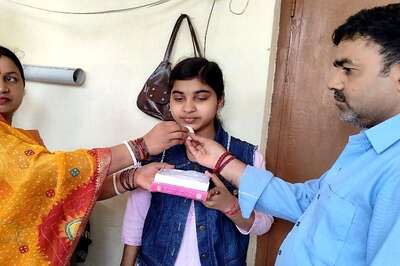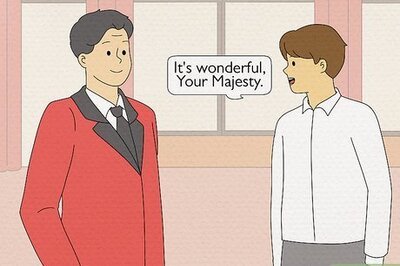
views
How to Single Crochet Decrease (sc2tog)
Insert the hook into the top loops of the next stitch of the previous row. Identify the loops by looking at the bumps along the top edge of your project. Each stitch looks like a “V” that tucks into the top of the next “V.” The two “legs” of the “V” are the two loops you work in. Insert your hook into the stitch from the front of the work and out through the back. A single crochet decrease stitch is abbreviated to sc2tog when you’re reading a crochet pattern. You may also see “dec” for decrease, meaning you should decrease using the same stitch you’ve been using in the pattern. In this case, it’s a single crochet stitch (or double crochet in the UK). A third way a decrease is noted is “crochet 2 stitches together.” Decreases are worked the same way when crocheting in the round as on flat rows. In most cases, use the same hook you use for the rest of the projects. Most patterns specify a hook size and yarn weight. However, if you’re practicing without a pattern, try an H-8 (5mm) hook with worsted-weight yarn. As you become more familiar with crocheting, you’ll be able to judge when to use a different-sized hook based on how tightly or loosely you crochet. As a beginner, it’s best to stick with the size the pattern calls for.
Yarn over (YO) and then pull the yarn through the stitch to make a loop. Hook the yarn with the end of your crochet hook. Then, pull the yarn back through the same stitch to make a loop on the crochet hook. There is now a total of 2 loops on your hook. Yarn over means to wrap the yarn around the hook so the hook can catch it. It’s one of the most common instructions in crochet patterns. This is the same way you start a regular single crochet stitch, but you don’t finish the stitch.
Insert the hook under the top loops of the next stitch. Move from the front to the back of your project as you insert the hook into the next stitch of the previous row. This step is similar to the first step because a decrease creates two stitches but connects them, so there’s only one stitch at the top. Then, when you are working the next row there’s one less stitch than in the previous row.
Yarn over (YO) and pull the yarn through the stitch. Catch the yarn with the crochet hook. Pull the yarn through the stitch, making a loop on the hook. There is now a total of three loops on the hook.
Yarn over (YO) and pull the yarn through all 3 loops on the hook. Wrap the yarn over the hook and pull it through the 3 loops on your hook to make a new loop. You’ve finished your decrease by taking 2 stitches and turned them into 1. There is still 1 loop left on the hook.
Making an Invisible Single Crochet Decrease (inv sc2tog)
Insert the hook under the front loops of the next 2 stitches. Instead of inserting the hook through both loops of a stitch (or “legs” of the “V”), only insert the hook in the loop that’s closest to you. Then, wrap the hook to the front of the piece and insert it into the front loop of the following stitch. You’ll have 3 loops on the hook. 2 of these are the front loops of the next two stitches in your row. In a pattern, an invisible single crochet decrease is often noted as “inv sc2tog” or “inv dec.”
Yarn over (YO) and pull through the front loops froof m both stitches. Hook the working yarn with your crochet hook. Pull it through both of the 2 front loops to make a new loop. There are now a total of 2 loops on your hook.
Yarn over (YO) and pull through both loops. Catch your working yarn with the hook again. Then, pull it through both of the loops on your crochet hook. This makes a new loop, which is the only loop left on your hook. An invisible decrease is ideal for amigurumi projects because it leaves fewer gaps and bumps, making a smoother surface.
How to Half Double Crochet Decrease (hdc2tog)
Yarn over (YO) the hook and then insert it into the next stitch. Yarn over (YO) before inserting the hook into the next stitch in the previous row. Then, insert your hook under both loops in the stitch. Yarning over the hook before inserting it into the next stitch distinguishes a half-double crochet stitch from a single crochet stitch.
Yarn over (YO) the hook and pull it through the stitch. Yarn over (YO) again and pull the working yarn through the stitch in the previous row to create a loop. This is the first stitch of the 2 you’re crocheting together. You now have 3 loops on your hook.
Yarn over (YO) the hook and insert it into the next stitch. After yarning over (YO), make sure to insert the hook under both loops in the next stitch. This begins the second stitch of the decrease.
Yarn over (YO) the hook and pull it through the stitch. This creates another loop. You now have a total of 4 loops on your hook.
Yarn over (YO) and pull through all four loops. This combines the 2 stitches into 1, completing the half-double crochet decrease.
How to Make a Double Crochet Decrease (dc2tog)
Yarn over (YO) the hook and insert it into the top of the next stitch. Start the first stitch of the double crochet decrease by wrapping the working yarn around the hook. Then, insert your hook into the next stitch under both loops. A double crochet stitch is twice the height of a single crochet and is known as a treble crochet in the UK.
Yarn over (YO) the hook and pull the yarn through the stitch. Wrap the yarn around the hook and pull it back through the stitch to make a loop. This makes a third loop on your hook.
Yarn over (YO) and pull the yarn through the first two loops. Wrap the working yarn around the hook. Then, pull it through only the first two loops on the hook. There are now 2 loops on your hook. This is the halfway point of the double crochet decrease. You may have noticed it’s identical to a normal double crochet stitch up to this point. The difference is you do not complete this first stitch before beginning the second.
Yarn over (YO) and insert your hook into the next stitch. Begin the second half of the decrease by wrapping the yarn around the hook. Then, insert the hook under both top loops of the next stitch in the previous row.
Yarn over (YO) and pull the yarn through the stitch. Wrap the yarn around the end of the hook from back to front. Then use the hook to pull the working yarn through the stitch to create a new loop. This leaves 4 loops on your hook.
Yarn over (YO) and pull the yarn through the first two loops on the hook. Wrap the working yarn around the hook from back to front. Catch the yarn with the end of the hook. Pull the yarn through the first 2 loops on the hook. This leaves 3 loops on your hook.
Yarn over (YO) and pull through all three loops on your hook. Wrap the working yarn around your hook from back to front. Use the hook to pull it through all three loops left on your hook. This finishes both halves of the decrease with a single stitch.
How to Make a Treble Crochet Decrease (tr2tog)
Yarn over (YO) twice and insert the hook into the top of the next stitch. Wrap the working yarn around the hook 2 times. This is what separates the treble crochet decrease from the double crochet decrease. Insert the hook into the top loops of the next stitch of the previous row. A treble crochet stitch (known as a quadruple crochet stitch in the UK) is double the height of a double crochet stitch.
Yarn over (YO) and pull up a loop through the stitch. Wrap the working yarn around the end of the crochet hook. Then, pull the yarn through the stitch to create a loop. There are now 4 loops on the hook.
Yarn over (YO) and pull through 2 loops twice. Wrap the working yarn around the crochet hook. Then, pull through the first 2 loops on the hook. Repeat this step. Up to this point, you have made a regular treble crochet stitch but don’t complete the stitch. This is the first half of your treble crochet decrease. Finish this step with 2 loops on the hook.
Repeat steps 1 - 3 to make the second half of the decrease. Yarn over 2 times and then insert the crochet hook into the top loops of the next stitch. Yarn over and pull the yarn through the stitch to make a loop. Then, yarn over and pull through 2 loops on the hook 2 times. Finish this step with 3 loops on the hook. This makes the second half of the treble crochet decrease.
Finish by yarning over (YO) and pulling the yarn through all 3 loops on the hook. Wrap the working yarn over the hook from back to front. Then, use the hook to pull the yarn through all 3 loops. This completes the treble crochet decrease. There is still 1 loop on your hook.
Decreasing More Than 2 Stitches
Continue to make partial stitches to decrease more stitches. A decrease usually crochets 2 stitches together to decrease your stitch count by 1. However, it’s possible to crochet 3, 4, or more stitches together to decrease 2, 3, or more stitches at a time. For example, here’s how to crochet 3 stitches together to decrease by 2 stitches. Yarn over and insert the hook into the top loops of the next stitch in the previous row. Yarn over and draw the working yarn through the stitch to make a loop. Yarn over and draw the working yarn through 2 loops on the hook.
Repeat steps 1 through 3 two more times. (Repeat the steps 3 more times to decrease by 3 stitches, etc.) You now have 3 unfinished double crochet stitches next to one another. There are 4 loops on your hook. Yarn over and draw through all 4 loops to finish with 1 loop on your hook.
How to Increase in Single Crochet (sc inc)
Increase by making 2 stitches in the same stitch from the previous row. Insert your hook in the top loops of the next stitch in the previous row. Yarn over the hook and pull the working yarn through the stitch to make a loop. Yarn over and pull the 2 loops on the hook. Next, insert your hook into the same stitch you just worked the single crochet in and repeat the process. Now, there are 2 single crochet stitches in the same stitch from the previous row, which increases the number of stitches by 1. An increase expands your piece and makes it larger. Increase the number of any type of stitch in a row by making 2 of that stitch in the same stitch from the previous row.
How do you prevent gaps between decreases?
There are a few different ways to prevent gaps in your decreases. The first option is to use more tension on the working yarn by holding it a little tighter as you yarn over. Another option is to use a hook that’s 1 size smaller than what you’re using for the rest of the piece. This makes the stitches smaller and tighter. Or, use an invisible decrease, which increases the tension of the stitch and pulls any gaps close. This is especially helpful for amigurumi projects because it gives the project a neater finish.
Where do increases and decreases go in a row?
Divide the number of stitches in the row by the number of decreases. The easiest way to decide where to place increases and decreases is to follow your pattern. However, some patterns aren’t specific. They may say something like, “Space 8 decreases evenly along the row.” In that case, all you have to do is take the full number of stitches in the row and divide it by the number of decreases the pattern calls for. This will tell you how many stitches to make between your decreases to keep them evenly spaced. For example, if your row has 40 stitches and you need to space out 8 decreases, divide 40 by 8 to get 5. Then, make a decrease every 5 stitches as you work your way down the row.



















Comments
0 comment